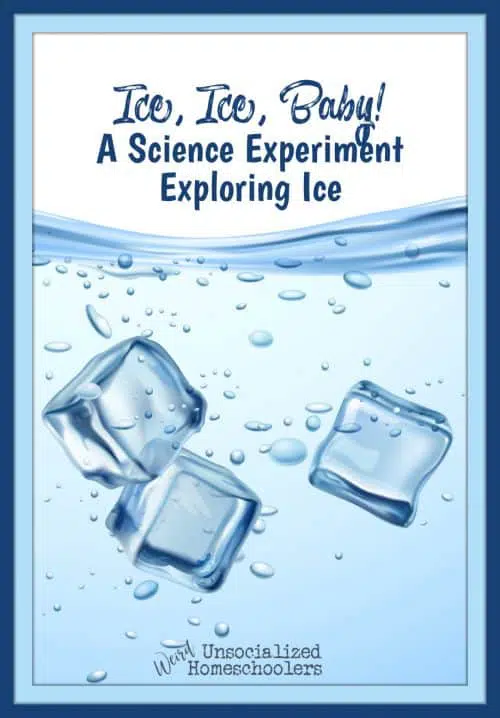Ice, Ice, Baby! An Easy Science Experiment Exploring Ice
Whether you’re looking to cool off during the summer or do some ice-and-cold-themed studies in the winter, a science experiment exploring ice fills the bill!
I am getting ready to show my age. Are you ready? Drum roll…Vanilla Ice, aka Robert Van Winkle, first recorded the song, Ice, Ice, Baby* during my high school years. It’s a catchy tune that was on the radio every 3 or 4 songs. Who knows what he really meant by the song but, regardless, ice is cool! (Haha, see what I did there?)
*If you want to show this YouTube video to your children, please watch it first to be sure it’s appropriate for them to view.

Experiments with ice are fascinating because they are so simple and they demonstrate one of the most basic physical changes (liquid to solid) to a very basic chemical compound.
Water is essential to human life. We need it to survive. Water makes up 71% of the earth’s composition and 60% of that of the human body. It’s even a major focus of space exploration. Scientists, humanitarians, and organizations around the globe are devoted to finding renewable sources of water.
Easy Science Experiment Exploring Ice
Water is simple. It’s made up of two atoms of hydrogen and one atom of oxygen – H2O. The water molecules dance around bumping into each other. The higher the temperature, the faster the dance. The lower the temperature, the slower the dance.
So, what is an easy experiment we can do with water and a freezer? Make ice, of course!
Do you think it matters if water is hot or cold when we place it in the freezer? Which do you think freezes first – cold water or hot? Let’s find out!
This is a study of a physical change, not a chemical change. Freezing water turns a liquid into a solid. Freezing water doesn’t change its chemical makeup, but only its physical state. It is still H2O. If you let the ice melt, it is still H2O. It is never not H2O.

What You Need and How to Do It
You will need:
- Two freezer-safe containers
- Measuring spoons
- Water
- A freezer
- Food coloring
First, measure 25 ml of cold water and 25 ml of hot water. (I measured 25 ml of water into a container and put it in the microwave for 20 seconds to heat the water. You can try heating on the stove or running it hot straight out of the tap if you prefer, though I would suggest the stove top or microwave.)
Add one or two drops of red food coloring so that you can identify which container holds the hot water.
Next, measure 25 ml of cold water into a container. You can either leave it natural (no food coloring) or add a drop or two of blue food coloring to identify it as the cold water.
Put both containers in the freezer and set a timer for one hour. They will most likely not be frozen at this point, so continue to check the two containers at one-hour intervals until both are frozen.

The Results Explained
In our experiment, at hour 3, the cold water was still not frozen solid but the hot water was!
What????
Was there some magic at work? It was the same water. Why was the result different?
The rate at which the hot water and cold water freeze is different because the cold water molecules are moving around more slowly, so it takes the cold water molecules longer to find a friend and bond. Because the hot water molecules are speeding around and bumping into other water molecules, they can find and bond with each other more quickly. It’s the difference between a slow dance and a frenzied mosh pit.
Diving Deeper
Now if you want to get a little deeper into it, you can add another chemical to the mix. Hydrogen peroxide – H2O2 – has a similar chemical makeup to water, but it has an extra oxygen atom. It is stored in a brown bottle to keep sunlight from degrading it and stealing that extra oxygen atom.
If you want to see what difference an extra oxygen molecule makes, pour 25 ml of H2O2 (remember, that’s hydrogen peroxide) into a third container. Add a drop or two of green food coloring (this is for reference and safety purposes).
Place this container in the freezer and check it at the same intervals as you did the water.
You’ll find that the hydrogen peroxide will freeze, but you can see the structure of “freezing” is different to the eye. The water has large clear parts. The H2O2 does not. You can see different crystals in the hydrogen peroxide and note that the texture is almost like that of a slushy.
Now, take the containers out of the freezer and set them on the counter for 30 minutes. You’ll see that the ice (H2O) starts melting.
In the container of water, you’ll notice that you have water and still have a small solid piece of ice. The frozen H2O2 (hydrogen peroxide) will act very differently. It will never be a solid mass with water around it. It will be slushy. You can’t break through the remaining solid H2O (plain water) with your finger, but you can break through the H2O2 with your finger since it’s slushy.
This is a fun, easy, and cheap science learning activity. You probably already have everything you need.

Another Fun Science Experiment Exploring Ice
So, here’s a question for you: is ice always cold? Seems like an easy “yes,” right? Not necessarily. Here’s another fun, ice-themed science experiment for you and you probably have everything you need for this one on hand as well. Let’s make hot ice!
What You Need to Make Hot Ice and How to Do It
You will need:
- 60ml baking soda
- 1 liter white vinegar
- Saucepan
First, pour the liter of vinegar into your saucepan. Then, begin adding the baking soda – but do it slowly or you’ll wind up making a baking soda volcano rather than hot ice! Just add a little and once the fizzing subsides, add a little more until you’ve combined all of the baking soda with the vinegar.
Once the two are combined, heat the resulting solution – sodium acetate – over low to medium heat until it begins boiling. Allow it to boil for approximately an hour. You want it to begin forming crystals on the surface of the solution.
Note: the solution may develop a yellow tint as it boils. Don’t worry if it does. Some discoloration is normal.
Once you’ve got some crystals and the solution has reduced down to 100-150ml (don’t worry about being too exact with this), you can remove it from the heat. Pour it into a heat-safe container, cover with plastic wrap to prevent further evaporation, and place it in the refrigerator for 30-45 minutes.
After the saucepan cools, scrape some of the crystals out of it and save them for the next step.
Once the sodium acetate solution has cooled, remove it from the fridge carefully and slowly begin to pour it over the crystals that you collected from your pan.
As the solution hits the crystals, it will begin crystalizing immediately, and the resulting ice will be hot to the touch! See how high you can grow your tower of hot ice. You may even attempt sculpting with it a bit as it crystalizes almost immediately.

How It Works
When you boil the sodium acetate, most – but not all – of the water is removed. The remaining water keeps breaking up the party for the crystals. They’re like would-be dance partners, but the water keeps cutting in and breaking them up.
When you place the sodium acetate in the fridge, it cools below the point where it would normally become a solid, a process known as supercooling.
Then, when you pour it, the crystals finally get to meet up with their dance partners and the solution begins to crystallize. Crystallization is an exothermic reaction so the resulting ice feels hot to the touch. (It’s not so hot that it will burn you, but is noticeably warm.)
By the way, the reason you have to move so carefully with the supercooled solution is that the crystals really want to dance so they don’t need much of an excuse. If they bump together, the reaction may start. The crystals that you saved from the saucepan are the dance floor – the catalyst that says, “They’re playing our song! (Ice, Ice, Baby, of course.) Let’s dance!”
So, see? Ice is really cool – except when it’s hot!
Try these simple, fun science experiments any time of year – as a summer cool down, an icy winter-themed science project, or anything in between. Do you follow us on social media? We’d love to see pictures or videos of your science experiments exploring ice!
You Might Also Like…
- Heat Transfer Experiment
- 10 Hands-On Science Activities for Kids
- Science for Kids: Salt and Ice Experiments
Jaime Lester Green is a wife and homeschool mom of 2 amazing children–a high school senior and an 8th grader. Loves all things science, is a NASA nerd and space geek, is addicted to crafting, and has way too many books (mostly crime novels and – you guessed it- science and space related).



